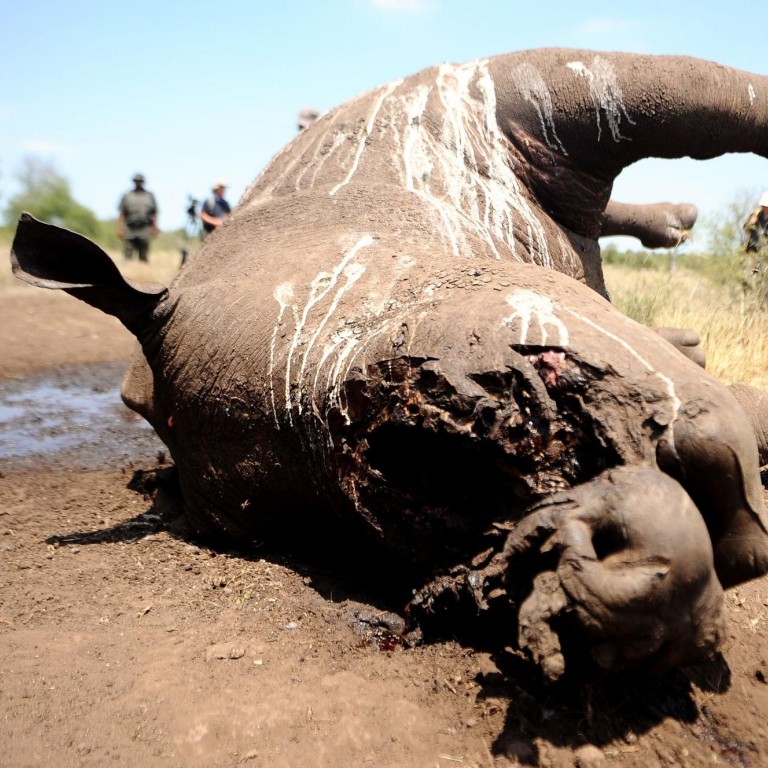
South Africa mulls legal trade in rhino horns in bid to defeat poaching
South Africa considers legalising the sale of its stockpile of horns in a bid to flood the market and put the criminal syndicates out of business
Pelham Jones bought his first rhinos for a private game park in South Africa some 25 years ago, completing his collection of the "Big Five" animals that visitors especially want to see.
"And then the heartache began," he says.
Now, as South Africa faces a seventh straight yearly increase in rhino poaching, Jones is on a panel of experts studying an unusual proposal for battling the problem: legalising the trade in rhino horn. The plan would involve selling tonnes of stockpiled horns that are in private and government hands.
He argues that flooding the market would pull the rug out from under crime syndicates by forcing down the price of rhino horn and removing the incentive to poach - all while providing cash to plough back into conservation efforts.

On the ground in South Africa, the impact is devastating, none more so than on the rangers and owners who find the rhinos' bloodied bodies with their horns and sometimes even their faces hacked off.
"When you stand next to a carcass, a dead pregnant female cow and a young heifer not 50 metres away, you weep," Jones said. "It's like the loss of a family member."
Internationally, the rhino-horn trade was banned by the Convention on International Trade in Endangered Species (Cites) in 1977. But a domestic trade continued within South Africa's borders for decades.
Then, in 2008, the country experienced a sudden increase in rhino poaching. The next year, the government passed a moratorium on the domestic trade.
It was supposed to close the loopholes that criminal syndicates were using to buy horns from local stockpiles. But some experts say it may have exacerbated the problem.
"The rhino-poaching crisis is being driven by a persistent demand for rhino horn that cannot be supplied through legal channels because of the national and international trade bans," a South African government report said.
"The ensuing high price of horn ... provided strong incentives for poachers to risk their lives to acquire horns through poaching."
A year after the moratorium was passed, South Africa lost 333 rhinos to poaching, followed by 448 in 2011, 668 in 2012, and 1,004 last year.
As of the beginning of November, poachers have killed 979 rhinos this year.
"We've tried everything else," says Jones, now head of the Private Rhino Owners Association.
The idea of legalising the trade has divided the conservation world.
"There are two lobbies," says Dex Kotze, an activist who helped organise a global march for rhinos and elephants last month.
"The government is working with the pro-trade lobby to legalise rhino horn and there's a whole lot of people that simply believe it's not going to work."
Kotze is one of them. A businessman from the luxury-goods industry, he keeps an eye firmly on the rising prices in Asia - a kilogram of rhino horn recently sold for US$100,000 in Vietnam, double the price of gold, he says - and believes the demand for rhino horn would far outstrip any legal supply.
"The massive build-up of wealth in Asian countries is a huge deterrent to making the trade legal. The numbers just do not make business sense from that point of view," Kotze said.
There is also criticism that the pro-trade lobby is promoting an argument from which it stands to benefit: in 2010, government and private owners were estimated to have more than 15 tonnes of rhino horn stockpiled, about a third of it belonging to the state.
If South Africa does decide to pursue a legal rhino-horn trade, it will have to win over two-thirds of member states at the next Cites conference in 2016.
UN says nature reserves are growing worldwide, but lack funding
Vast areas of land and sea have become environmental sanctuaries in recent years, but are not being funded adequately, the UN says.
The United Nations Environment Programme (Unep) said that countries were on track to meet targets to protect 17 per cent of land and 10 per cent of marine areas by 2020.
The warning comes as thousands of delegates attend this week's World Parks Congress in Sydney, Australia, to lay out a global agenda for protected areas over the next 10 years. The Unep, citing a 2012 estimate, said US$76.1 billion was needed each year to effectively establish and manage the world's protected areas.
Unep executive director Achim Steiner said taking care of sanctuaries was critical to tackling climate change and supporting biodiversity. "This report shows that the will to do so is present," he said. The UN agency estimates 15.4 per cent of land and inland water areas and 3.4 per cent of oceans - 32.6 million sq km in all - are now protected areas, up 1.6 million sq km since 2012.
Some of the world's largest sanctuaries on land include Northeast Greenland National Park in Greenland and Rub al-Khali in Saudi Arabia.
But the report warned that only 0.25 per cent of the high seas - open ocean outside territorial waters - was currently included, "highlighting the urgent need to overcome challenges in establishing such areas where national governance systems do not exist".
A further 21.5 million sq km of the high seas need to be protected to meet the 2020 goals, which were outlined at the Convention on Biological Diversity's last meeting in Japan in 2010.
